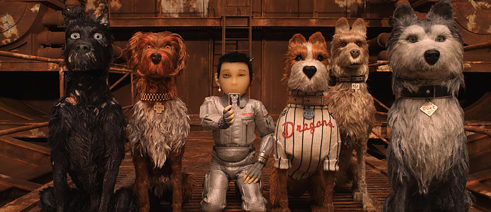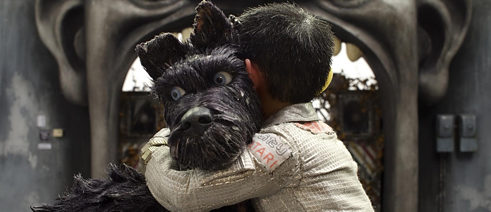Berlinale Bloggers 2018
Isle of Dogs: A Return to Form For Wes Anderson?

Our blogger Grace Barber-Plentie saw Wes Anderson’s animation ‘Isle of Dogs’: Why the film is emotionally rewarding to pet owners and animal haters alike, but still not quite up to scratch.
Wes Anderson doesn’t like animals - just ask the internet. Type “Wes Anderson animals” into Google and the first thing that comes up is “Why Does Wes Anderson Hate Dogs?”, followed immediately by “Why Does Wes Anderson Hate Cats?” There are whole Reddit forums dedicated to this topic and this topic alone. While the man may love symmetry and Futura font, animals are something he is not fond of.
So when it was announced that Anderson was making a second stop-motion feature, Isle of Dogs, I’ll admit I was somewhat confused. A man who’s callously killed off man’s best friend in at least two of his films, turning to dedicate an entire film to them? Something seemed a little off. But perhaps the most bizarre thing about Isle of Dogs is that, for the most part… it works.
What’s it about?
Similarly to Anderson’s last two films, The Grand Budapest Hotel and Moonrise Kingdom, Isle of Dogs takes one small scenario - say, a missing painting, a missing pair of teen lovers or, well… a missing dog - and expands it like a spiderweb, gradually introducing a host of crazy characters, flashing between past and present, and usually culminating in a showdown. With a lot of directors it would be frustrating to see them following the same method for three films in a row, however by changing time period, form and setting in each film, Anderson manages to at least give us something new in each film.
This time Anderson takes us to a futuristic Japan, where the corrupt cat-loving Mayor Kobayashi has banned dogs and exiled them to “trash island” - set to live out the rest of their lives succumbing to canine flu and fighting for scraps. However the equilibrium of this dogless world is rocked when Kobayashi’s ward Atari sets off to the trash island to find his beloved dog Spots. It’s a simple enough plot - and in fact, thanks to a red herring, it’s nearly over before it’s even began - yet besides this tale of boy looking for his best friend, Anderson also throws political corruption, plucky scientists, student activists and a message on animal testing into the mix, most of it successfully combining to give an adventure that’s gripping from start to finish.
Is it any good?
What never quite lands, at least for me, is the film’s setting of Japan. Anderson walks a tricky line here because while every filmmaker should of course be allowed to explore worlds beyond what they know, the question still remains of - well, why? Anderson seems dedicated enough to making his location choice as authentic as a dystopia can be, from a recurrent visual gag involving Hokusai’s The Wave, to exploring Samurai culture. Yet if we’re to believe in the rule of “write what you know”, there’s nothing about this film that couldn’t have been tweaked somewhat and changed to an American setting. Certainly nothing would have been lost, and nothing really seems to have been gained from choosing to set the film in Japan.So while the location of Isle of Dogs may not entirely work, one thing that must be praised is the dogs themselves. The film’s animation is exquisite, blending a range of animation techniques effortlessly and imbuying all of the film’s characters (even those who fall into uncomfortable caricatures such as the Mayor’s head stooge) with a sense of life and character. While Anderson’s characterisation never goes into the depth of his early films such as Rushmore and The Royal Tenenbaums, each character, be they human or canine, has enough sense of self that we’re willing to follow them for the film’s 101 minutes. As with every Anderson film, this is a story of misfits - and Brian Cranston’s gruffly voiced Chief, the leader of a pack of dogs, is a perfect example of this. We know from the moment that the initially curmudgeonly Chief appears on-screen that he’s going to go full circle and be redeemed, but the level of craft that goes into creating Chief, and Cranston’s voicework mean that any eyerolls about a predictable Wes Anderson character arc fall by the wayside.
But while I could praise the film’s animation and voicework until the cows (or canines) come home, one thing that struck me about Isle of Dogs is the welcome return of Anderson’s emotionally resonant filmmaking. It’s easy to think of Wes Anderson as a cute, preppy director (although one now-equipped with an Academy Award, lest we forget) going through a checklist of filmmaking techniques to send any film student in rapture, but the reason I’ve held onto a love of Anderson’s filmmaking despite my tastes growing over the years is because it’s made me feel things. Be that laughter, tears or anger, Anderson usually manages to give us something in his films, making a simple throwaway line for Ben Stiller’s character in the Royal Tenenbaums - “I’ve had a tough year, dad” - the emotional heart of his character. While Grand Budapest Hotel is now largely considered to be one of Anderson’s best films, I personally consider it one of his weakest - because I felt absolutely nothing whilst watching it.
In Isle of Dogs on the other hand, all the emotions are there. Anderson’s not a melodramatic director who aims to tug the heartstrings - rather he might happen to pull the right chord here and there to make you feel something. Isle of Dogs could easily fall into cliché when it comes to showing relationships between humans and our beloved pets, but Anderson doesn’t need to spell it out for us. Anyone who’s ever had a pet will feel the emotional resonance here. And anyone who hasn’t or is an animal hater like Anderson is rumoured to be, might be able to get a bit more an insight into what feeling a connection to an animal is like.
While Isle of Dogs never quite reaches the heights of Anderson’s early career, it’s certainly a valiant piece of filmmaking, and one that drags the director out of what could’ve easily turned into a period of stagnation. It will certainly be interesting to see what Anderson goes on to make next - and particularly if any animals are hurt during the making of it.
